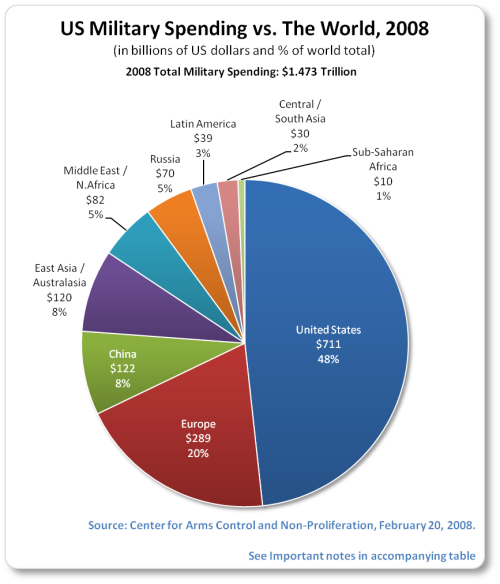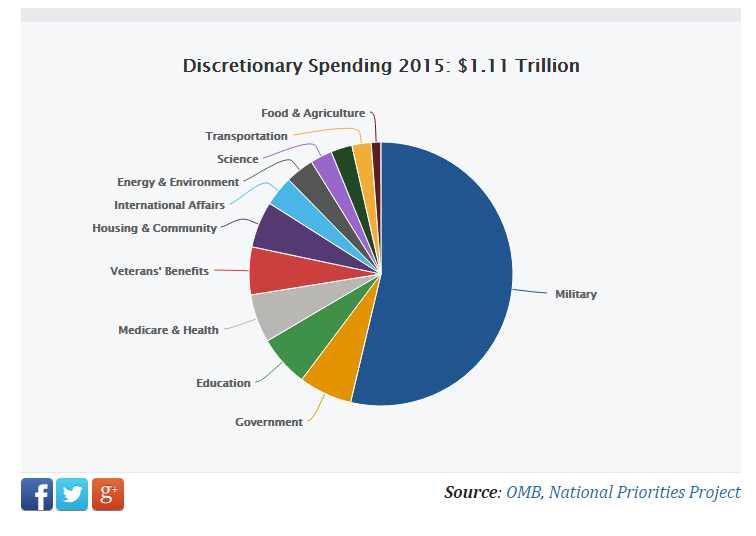The outstanding US public debt is over $11 Trillion and the interest payments alone total over $22B per month. The unemployment rate reached 10.2% in October. The number of unemployed persons now stands at 15.7 million. The true unofficial unemployment rate U6 is over 17%. While the federal government and the states have taken various cost cutting initiatives in the past few months, one question that the mainstream media, think tanks and other outlets failed to ask the politicians is this: Should we drastically cut the bloated military budget to help solve some of the economic problems facing this country?. There should no sacred cows when it comes to finding ways to reduce the ballooning deficit.
US defense expenditures have been soaring since the 2001 9/11 terrorist attacks. In 2008, the US spent $711B accounting for 48% of the world’s defense expenditures as the chart shows below. Russia, the former superpower spent just $70B. Europe accounted for 20% of global defense spending. The US defense spending was more than the combined total of the next 45 countries.

Last month, President Obama approved a $636B defense budget for 2010. This includes $128B for the wars in Afghanistan and Iraq. By one estimate the 2010 budget is a 0.20% increase from the 2009 budget.
The chart below shows select U.S. defense-related expenditures since 1960 from the Balance of Payments data published by the BEA.
Click to Enlarge
Source: U.S. Bureau of Economic Analysis (BEA)
Note: The 1991 figure includes $42.5B received from coalition partners for the Persian Gulf war.
The three defense-related items shown in the chart are: Transfers under U.S. military agency sales contracts, Direct defense expenditure and U.S. government grants. These three expenses appear in the current account section of Balance of Payments data and represent the amount the US spends to police the world. From under $20B prior to 1980 this amount increased to $95B in 2008.
For spending this amount of money, the overall U.S. economy benefits much less. A recent study by Global Insight, the respected economics research firm, shows that increased defense spending leads to job losses.
From the article titled “Massive Defense Spending Leads to Job Loss” by Dean Baker of the Center for Economic and Policy Research:
For example, defense spending means that the government is pulling away resources from the uses determined by the market and instead using them to buy weapons and supplies and to pay for soldiers and other military personnel. In standard economic models, defense spending is a direct drain on the economy, reducing efficiency, slowing growth and costing jobs.
A few years ago, the Center for Economic and Policy Research commissioned Global Insight, one of the leading economic modeling firms, to project the impact of a sustained increase in defense spending equal to 1.0 percentage point of GDP. This was roughly equal to the cost of the Iraq War.
Global Insight’s model projected that after 20 years the economy would be about 0.6 percentage points smaller as a result of the additional defense spending. Slower growth would imply a loss of almost 700,000 jobs compared to a situation in which defense spending had not been increased. Construction and manufacturing were especially big job losers in the projections, losing 210,000 and 90,000 jobs, respectively.
The scenario we asked Global Insight to model turned out to have vastly underestimated the increase in defense spending associated with current policy. In the most recent quarter, defense spending was equal to 5.6 percent of GDP. By comparison, before the September 11th attacks, the Congressional Budget Office projected that defense spending in 2009 would be equal to just 2.4 percent of GDP. Our post-September 11th build-up was equal to 3.2 percentage points of GDP compared to the pre-attack baseline. This means that the Global Insight projections of job loss are far too low.
The impact of higher spending will not be directly proportionate in these economic models. In fact, it should be somewhat more than proportionate, but if we just multiple the Global Insight projections by 3, we would see that the long-term impact of our increased defense spending will be a reduction in GDP of 1.8 percentage points. This would correspond to roughly $250 billion in the current economy, or about $800 in lost output for every person in the country.
The projected job loss from this increase in defense spending would be close to 2 million. In other words, the standard economic models that project job loss from efforts to stem global warming also project that the increase in defense spending since 2000 will cost the economy close to 2 million jobs in the long run.
For a given amount of spending, the number of jobs created by the defense sector is actually less than the number of jobs created by other sectors of the economy. An article in Naked Capitalism references a study titled “The U.S. Employment Effects of Military and Domestic Spending Priorities†by the economist Robert Pollin at The Political Economy Research Institute at the University of Massachusetts, Amherst. The following chart and table are from the updated version of this study:
Employment Effects of Spending $1B on various sectors:


Spending $1 billion on the military creates just 7,100 jobs whereas spending the same on educational services creates 16,900 jobs and on health care creates 10,400 jobs.
Clearly military spending does not help the economy like other sectors do. Sure some might argue that many cool technological advancements have come out of military research such as the Internet, GPS, etc. But those are just by-products of military research that benefited the growth of civilian economy. Civilian sectors can produce much more inventions and help provide jobs stimulating the economy if the same amount of funds are invested in civilian projects. Even Nobel Laureate Paul Krugman recently agreed that defense spending creates a short-term boost to the economy. In the long-run military spending is wasteful. Most of the defense funding is allocated to pork belly projects of politicians to keep their constituents employed and the defense industry reap huge profits. Another example of wasteful spending by the Pentagon came to light today with this news item: $400 per gallon gas to drive debate over cost of war in Afghanistan.
The Pentagon pays an average of $400 to put a gallon of fuel into a combat vehicle or aircraft in Afghanistan.
Pentagon officials have told the House Appropriations Defense Subcommittee a gallon of fuel costs the military about $400 by the time it arrives in the remote locations in Afghanistan where U.S. troops operate.
Last month there was another case of wasteful spending when the Senate was set to fund $2.5 B for C-17 cargo plane production which were unwanted by the Pentagon.
This $400 a gallon, $2.5B for unwanted planes are just the tip of the iceberg. Billions of tax-payer dollars are skimmed off from the military by others such as the private military contractors, consultants that have enjoyed tremendous growth in recent years.
Why does it take $600+ billion to run the military?
According to the latest figures available, as of 2007 “Pentagon is today one of the biggest land owners in the world. The 737 military bases it possesses worldwide (in addition to the bases located in US territory) occupy a total area of 2.2 million hectares. They include 32,327 buildings and employ nearly 500,000 people, including 400,000 American military and civilian personnel. In Germany only, there are 25 American bases, employing 75,600 military people. In Italy, the most important American bases
(Aviano, Camp Ederle in Vicenza, Ghedi, Camp Darby at Pisa, Napoli, Verona, Sigonella in Sicily, La Maddalena in Sardinia) occupy an area of more than one million square kms and employ 15,500 military people and 4,500 civilians.
The historian Chalmer Johnson (*The Last Days of the American Republic*, 2007), who was a CIA consultant between 1967 and 1973, has recently stressed that these figures do not include the 106 American garrisons installed since May 2005 in Iraq and Afghanistan, nor the ones built in Israel, in Qatar, in Central Asia, in Kyrgyzstan and in
Uzbekistan, nor the enormous base of Camp Bondsteel, built in 1999 in Kosovo by a subsidiary of Halliburton company, nor of course the multiple NSA installations (like the Echelon net) devoted to the illegal espionage and hearing of personal communications throughout the world (including yours and mine).”
In addition to the two unpopular wars, the Pentagon needs billions of dollars each year just to maintain the facilities mentioned above. Some 1.4 million military personnel serving the country also cost a significant amount of funds in terms of benefits, payroll, etc. In the current economy, military is one industry that is actively recruiting people and in some ways is helping to keep the unemployment numbers low.
In summary, though defense spending is beneficial to the economy in the short-term, in the long-term it is not. In most countries military spending is much lower than US defense expenditures and those countries are able to allocate those funds for other productive investments. Since the Cold War is long over and the Berlin Wall no longer exists, isn’t it time for the US to wind down its global empire and concentrate on domestic issues?
Update – 7/26/15:
Source: Federal Spending: Where Does the Money Go, National Priorities Project




